Weathering the Storm

This article is an update on the impact of boxwood blight at the Estate. Previous articles written in 2014 and 2022, titled “Threatening Clouds on the Horizon” and “The Storm is Here,” respectfully, can be found on our website.
In a 1920 Country Life magazine article on Ferrell Gardens titled, “The Garden of Memories,” Barbara Madison Tunnell states, “The gardens are the soul of the estate and their spirit is the spirit of Sarah Coleman Ferrell. No form of artistic expression seems so potent for the conveyance of atmosphere – the aroma of the spirit of its creator – as a garden.” For over 180 years, Sarah’s ideas and designs have been preserved and extended into what we know as Hills & Dales Estate today. However, this has not been an easy road. There have been losses, changes, triumphs, failures, and tragedies throughout the history of the garden. New caretakers have added their own personal touches while also celebrating and protecting the work of those who came before them. As we celebrate our 20th anniversary as a home and garden museum, we reflect on the history of the garden, the trials and tribulations its caretakers have faced, and the current undertakings by our garden staff.
The Creation
When Sarah Ferrell started her gardens, then called “The Terraces,” in the mid-1800s, she designed them as an expression of her faith and love of God. One specific area, which she called “the Church,” is set apart from the other plantings on the same terrace by steps. This essentially square garden room contains elements, planted in boxwood, that would historically be found in any church: a lyre harp, a pipe organ, a water feature, high-backed pews, and an offering plate. Under Ida Cason Callaway’s tenure, the church theme was continued through the planting of flowers symbolizing things normally found in a congregation: Sweet William and zinnias, also known as Old Maids, representing the men and women; Jack in the Pulpit for the minister; and yellow marigolds planted in the offering plate to symbolize gold coins. Alice Hand Callaway changed the plantings of the Church Garden to the mostly white-blooming species seen today, as white often indicates purity, innocence, and sacredness.
Another religious motif planted in boxwood by Sarah Ferrell is a large bunch of grapes located adjacent to the Church Garden. In articles written about the garden and stories told by Alice, this planting refers to the biblical story of the Grapes of Eschol in the book of Numbers, in which spies investigating the Promised Land carried out a bunch of grapes so large that two men had to carry it on a pole between their shoulders. On her garden tours, Alice would say that Sarah considered this property her Promised Land.
The New Era
Following Alice’s death in 1998, the home and garden were bequeathed to the Fuller E. Callaway Foundation. Since then, the care of the historic gardens has been overseen by several different professional gardeners. Like Ida and Alice, they continued the tradition of preserving Sarah’s original design, but also faced the reality that gardens naturally change over time. Sunny areas became shady as canopies expanded. Some specimens died during harsh winters, while others thrived and overgrew their boundaries. Storms toppled trees and completely changed micro-climates, sometimes with drastic effects. The process of preserving a historic garden is, ironically, constant change. While their personalities were different and approaches shifted slightly, the new caretakers never wavered from the overarching goal of preserving the original spirit and design. But the challenges a gardener faces are never ending, and sometimes nature deals a deadly hand.
The Storm
In December 2020, the dreaded boxwood blight, a destructive fungal disease that originated in Europe, was found on shrubs at our Visitor Center. Though swift action was taken to prevent the spread, blight was discovered in the Church Garden in the fall of 2021, and the garden has remained closed since. Blight was also found on the Grapes and Florida Lane during this time. This was devastating to the staff as English boxwood, which makes up much of the boxwood in the old garden, is most susceptible to blight. Aggressive fungicidal spraying and careful and frequent monitoring were used in an attempt to contain the spread. However, the blight persisted, infecting the boxwood that created key features of the Church Garden, such as the harp and offering plate. The nearby Grapes were also compromised to the point that the designs were unrecognizable. The question then became what is more important, preserving Sarah Ferrell’s original designs or saving the historic boxwood plants themselves?
During this same period, the garden once again fell under the care of a new manager. Jo Phillips had recently retired as Horticulture Manager after 28 years of continuous employment and JoHannah Biang stepped into that position. Under her leadership, the garden staff removed the newly infected boxwood, as well as the surrounding healthy boxwood, from the Church Garden and Grapes and replanted boxwood cultivars that show the most resistance to boxwood blight. The following is from her perspective as the new Horticulture Manager.
About eighteen months ago, I was hired as the newest staff member of Hills & Dales Estate in the role of Horticulture Manager. To say I was intimidated by the tasks that laid ahead would have been an understatement. I was to follow in the footsteps of Jo Phillips, who not only worked at the estate for almost three decades but was the final horticulture staff member to work directly with Alice Callaway before Alice passed away in 1998. I felt proud to be the next woman who would manage the upkeep of the gardens, but, at the same time, I felt the heavy responsibility of doing them and the gardens justice. Many strong women had overseen these gardens – from Sarah Ferrell in the 1800s, to Ida Callaway in the early 1900s and Alice Callaway in the mid-1900s, and then later to Jo Phillips. These were big shoes to fill indeed, and, despite my formal horticultural training, I felt overwhelmed just like Alice did when she took over the garden at the age of 24 in 1936.
Unfortunately, that was not the only challenge I faced. Another challenge had swept through the oldest, most beloved parts of the garden, mainly the Church Garden and the Grapes. Cherished boxwood had become infected, and staff had removed compromised plants and closed off the area. Boxwood blight had finally made its way to Hills & Dales Estate after ravaging other historic boxwood gardens in the Eastern United States. This blight forced the horticulture staff to focus their efforts on developing a boxwood blight management plan – a protocol for eradicating infected plants and preventing further spread. In this plan, if blight was detected, staff burned the infected plants and several surrounding plants, removed them, and then burned the soil surface to kill any remaining fungal spores. Preventative fungicides would also be sprayed through the peak blight season in the hopes of preventing further spread.
The challenge I then faced was creating a plan for restoring the plantings that had been lost in the hopes of one day reopening those most beloved portions of the garden. My first step was to research the blight disease to see what others were doing to combat it. While doing this research, I found several newer cultivars that were showing more resistance to the disease. This was the NewGen line of boxwood developed by Saunders Genetics in Virginia. We decided to order some and test them out in a small area of the Church Garden known as the offering plate, which was compromised due to numerous boxwood being removed. Because I wanted a lower and slower-growing cultivar for this design, I chose NewGen Independence. Once they were planted in the spring of 2023, we decided not to spray the new plants with preventative fungicides because we wanted to see how they would do on their own. As of June 2024, they look great and are still blight free!
Based on the success of the offering plate planting, we decided to replant the harp this year. Unfortunately, the harp was severely damaged by blight last year to the point where the design was completely unrecognizable. We purchased the same NewGen Independence and replanted the harp this past spring. We are hopeful that it will stay blight free as we enter this year’s blight season.
In addition to the main designs, many of the parterres in the Church Garden have also been so damaged by blight that they have a snaggle tooth look. To avoid a complete monoculture of NewGen, I wanted to test some boxwood alternatives. There are pockets in the Church Garden that are deep in shade, which makes choosing an alternative like a yaupon holly or a soft touch holly challenging since these plants typically need more sun. To test this, I purchased several different types of holly early in 2023 to see how they would do in the shade. While they survived through the year, the yaupon and soft touch holly stretched and became leggy. During this time, I read a cultivar study on boxwood that showed resistance to blight. One that was mentioned was ‘Little Missy’. This variety is older than the NewGen cultivars, so I decided to purchase some of them to test. It has the advantage of being less expensive than NewGen, demonstrated good blight resistance, and has a longer track record of performance. We ordered 132 Boxwood ‘Little Missy’ this spring and began replanting the parterres with them. So far, they are doing well. We will see how they progress through the summer.
The Rainbow in the Sky
Due to their success with the offering plate, JoHannah and the garden staff are hopeful that they will continue to see resistance with the NewGen cultivars in the harp and the ‘Little Missy’ in the surrounding parterres. Going forward, the plan is to continue replacing sections of the Church Garden each year and continuing the boxwood tradition.
Today, blight has taken its toll on the Grapes and the iconic design has been lost, while the surrounding pathways have been blocked off as a precaution to prevent further spread. A picture of a historic postcard shows what the grapes looked like in about 1950, and we hope to be able to recapture that beauty following the planned replanting in 2025. JoHannah and the garden staff are optimistic that parts of the Church Garden can be reopened early this fall, allowing guests to walk through the middle of the garden to see our progress and ponder our ongoing challenges.
Writer May Sarton once said, “The garden is growth and change and that means loss as well as constant new treasures to make up for a few disasters.” Despite the losses suffered by the garden due to boxwood blight, the integrity of Sarah Ferrell’s original designs, as well as the work of Ida and Alice Callaway, has stood the test of time. It is the hope of JoHannah and the rest of the staff that, despite the inevitable changes that the garden will face, it will continue to be preserved and enjoyed for many more years to come. While we may not be able to keep the historic boxwood planted by Sarah Ferrell and Ida and Alice Callaway, we can maintain their designs with newer cultivars, keeping the spirit of the garden alive and well. ~JB & HM
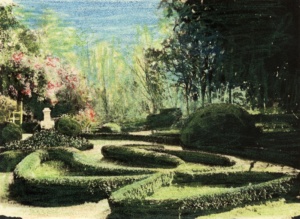
This image of the harp was used in a slideshow delivered by Constance K. Draper to the Peachtree Garden Club of Atlanta, using information from Ida Cason Callaway and Barbara Madison Tunnell. Circa 1925. Photo courtesy of the Cherokee Garden Library at the Kenan Research Center at the Atlanta History Center. |
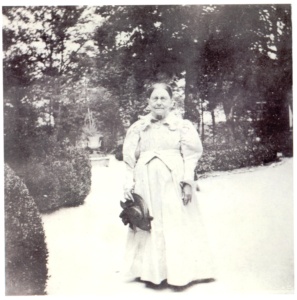
Sarah Coleman Ferrell standing in her garden, circa 1890. |
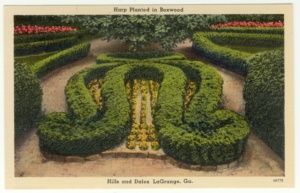
This 1930s postcard depicts the harp as it was when Alice Callaway took over as caretaker of the garden. |

1930s postcard of the Grapes. |
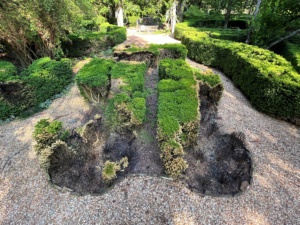
The Harp before replanting with NewGen. |
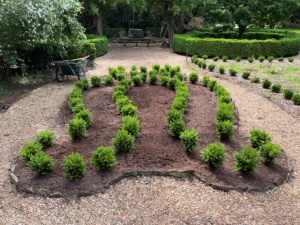
The Harp after replanting. |
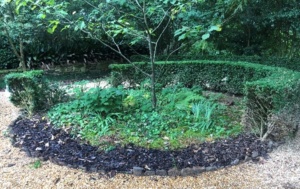
The Offering Plate in the Church Garden was one of the areas damaged by boxwood blight. This shows it before replanting with the NewGen boxwood. |
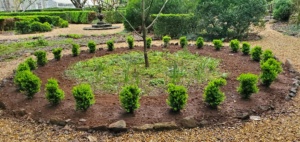
The Offering Plate after replanting. |

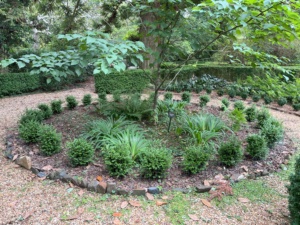
A current picture of the Offering Plate. |
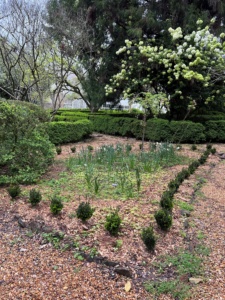
The boxwood parterres replanted with ‘Little Missy’ |
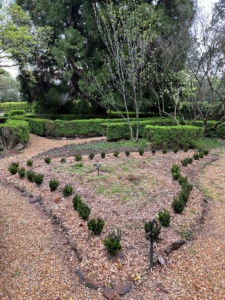
The boxwood parterres replanted with ‘Little Missy’ |
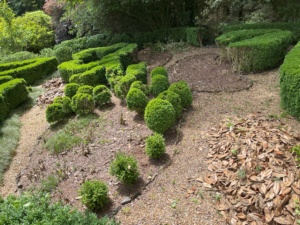
The Grapes planting was also decimated by boxwood blight, which is especially evident when compared to the 1930s postcard shown above. |
View this entire Portico Newsletter: